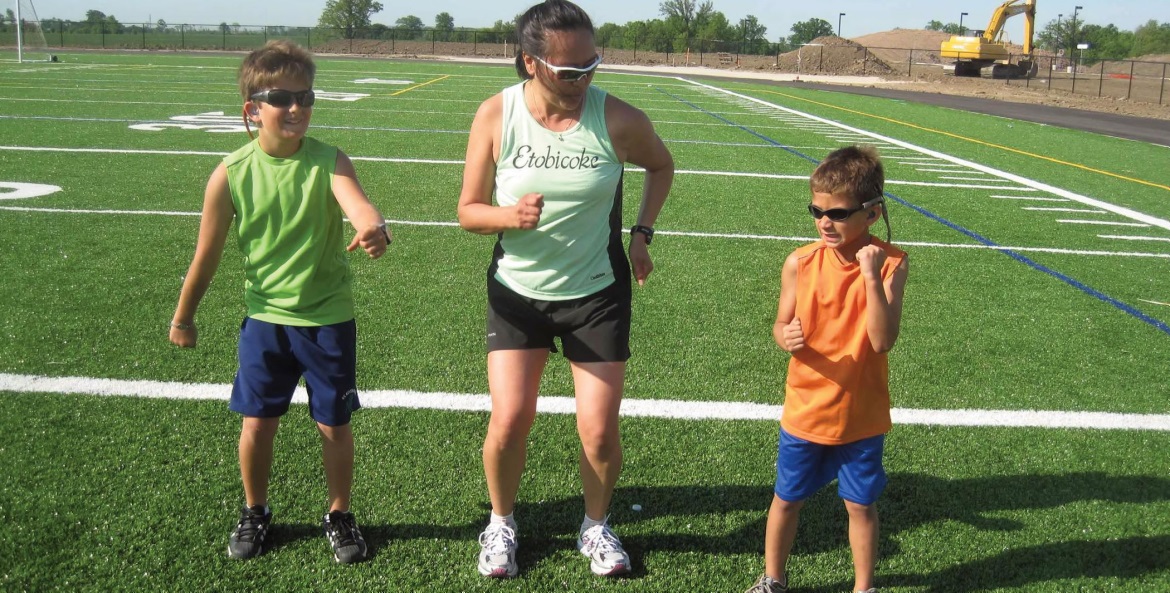
RUNNING START: Ethan (left) and Gavin with their PT, Sharon Shew, practicing running; "At first, they couldn't run in a straight line, but they persisted and eventually entered races."
grams, puzzle games, and trivia. We had trivia games for Space, Canada, Canadian geography, Countries of the World, Famous Inventions, and more. When we moved to New Jersey, we bought the States, the History of the United States, and the Civil War. A family tradition developing from this was an unexpected bonus.
VISION FOR THE FUTURE
Ethan and Gavin were later diagnosed with Usher syndrome at the ages of 7 and 5 years old. We welcomed a Teacher of the Blind and Visually Impaired (TVI) and an Orientation and Mobility Instructor to their team of specialists. We knew that there were accommodations they needed for their low vision, night blindness, and difficulty with contrast vision, and we wondered when to teach them the special skills and tools they needed to navigate their surroundings as their vision loss progressed. As with everything, we navigated the situation the best way we could with the information we had, and looked to the boys to help us figure out what they could handle. We started by letting them know that their eyes, like their ears, needed help as well, and a teacher would be working with them to help them just like their TOD. It turned out, they knew exactly what they needed. They came home excited to tell us that they had pointed out where yellow tape would help them, and in what parts of the school they had difficulty seeing because of bad lighting. They worked with a TVI throughout their school years, to ensure that their needs were being met in terms of font size, use of contrast, books on tape, and other accommodations that were appropriate for their visual needs. Through elementary and middle school they had cane training and in high school they decided to learn the basics for braille. For now, they prefer using sighted guides and relying on friends and family to assist them while their white canes hang on a stick by the door. For our part, we have concentrated on providing them with opportunities to travel and have as many visual experiences as possible. They have participated in events with the Visual Experience
Foundation, including a Bus Tour of New York City and their Surfing for Vision event on the Jersey Shore, where they were encouraged to save their memories through a visual 'Burn It' experience.
FINDING BALANCE
During the summer of 2019, I wrote a blog for the Usher Syndrome Coalition about our approach to our children's lack of balance (see resources). I was at the 2019 Adaptive Sports Junior Nationals watching my children compete in swimming, track, and field events; Ethan was 17 and Gavin was 15 at the time. For me, I couldn't believe that these were the infants who couldn't hold up their heads, the babies who couldn't sit on their own and the toddlers who couldn't walk…not to mention the challenge of their combined hearing and vision loss. They would go on to compete and have success in para swimming events across the country, even the National Paralympic Championships. Despite their challenges, they were ATHLETES competing on a national level.
Unfortunately, the pandemic swiftly put an end to their paralympic goals and dreams, for many different reasons. There was certainly the disappointment that accompanies such abrupt ends, but I reminded myself that those were the unexpected bonuses that came as a result of the years of therapy and training. It started with occupational therapy, when they were babies, to strengthen their motor skills and deal with their sensory integration issues. Then physical therapy, when they were toddlers, to work on their vestibular dysfunction. It took a few years and different physical therapists, but eventually we found a neuro Physiotherapist (PT), Sharon Shew, at Mobile Health in Milton, Ontario, Canada, who explained that we needed to build their strength and help them develop a strong core to compensate for their missing senses.
A program was designed for them that combined traditional physical therapy and personal training. They had a plan for home using weights, a stability ball and a bosu ball. They also met with